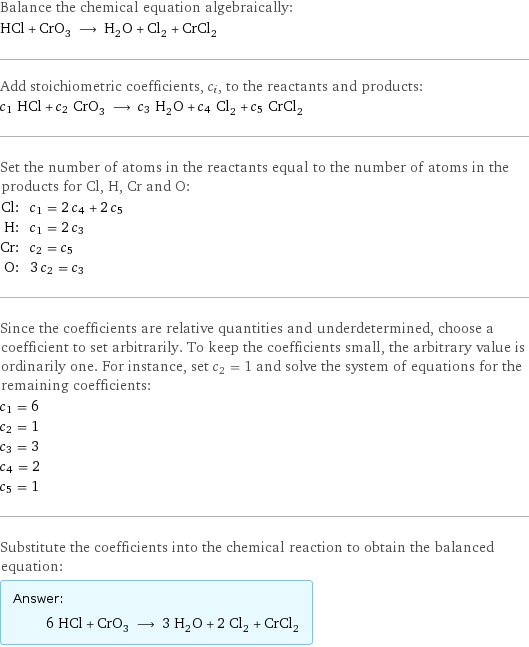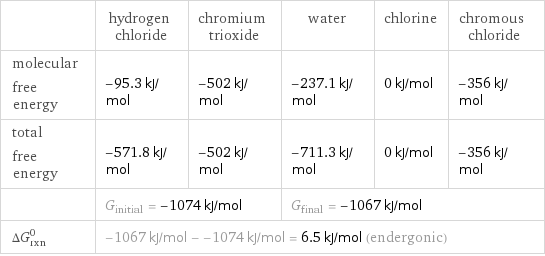Input interpretation

HCl hydrogen chloride + CrO_3 chromium trioxide ⟶ H_2O water + Cl_2 chlorine + CrCl_2 chromous chloride
Balanced equation

Balance the chemical equation algebraically: HCl + CrO_3 ⟶ H_2O + Cl_2 + CrCl_2 Add stoichiometric coefficients, c_i, to the reactants and products: c_1 HCl + c_2 CrO_3 ⟶ c_3 H_2O + c_4 Cl_2 + c_5 CrCl_2 Set the number of atoms in the reactants equal to the number of atoms in the products for Cl, H, Cr and O: Cl: | c_1 = 2 c_4 + 2 c_5 H: | c_1 = 2 c_3 Cr: | c_2 = c_5 O: | 3 c_2 = c_3 Since the coefficients are relative quantities and underdetermined, choose a coefficient to set arbitrarily. To keep the coefficients small, the arbitrary value is ordinarily one. For instance, set c_2 = 1 and solve the system of equations for the remaining coefficients: c_1 = 6 c_2 = 1 c_3 = 3 c_4 = 2 c_5 = 1 Substitute the coefficients into the chemical reaction to obtain the balanced equation: Answer: | | 6 HCl + CrO_3 ⟶ 3 H_2O + 2 Cl_2 + CrCl_2
Structures

+ ⟶ + +
Names

hydrogen chloride + chromium trioxide ⟶ water + chlorine + chromous chloride
Reaction thermodynamics
Gibbs free energy

| hydrogen chloride | chromium trioxide | water | chlorine | chromous chloride molecular free energy | -95.3 kJ/mol | -502 kJ/mol | -237.1 kJ/mol | 0 kJ/mol | -356 kJ/mol total free energy | -571.8 kJ/mol | -502 kJ/mol | -711.3 kJ/mol | 0 kJ/mol | -356 kJ/mol | G_initial = -1074 kJ/mol | | G_final = -1067 kJ/mol | | ΔG_rxn^0 | -1067 kJ/mol - -1074 kJ/mol = 6.5 kJ/mol (endergonic) | | | |
Equilibrium constant
![Construct the equilibrium constant, K, expression for: HCl + CrO_3 ⟶ H_2O + Cl_2 + CrCl_2 Plan: • Balance the chemical equation. • Determine the stoichiometric numbers. • Assemble the activity expression for each chemical species. • Use the activity expressions to build the equilibrium constant expression. Write the balanced chemical equation: 6 HCl + CrO_3 ⟶ 3 H_2O + 2 Cl_2 + CrCl_2 Assign stoichiometric numbers, ν_i, using the stoichiometric coefficients, c_i, from the balanced chemical equation in the following manner: ν_i = -c_i for reactants and ν_i = c_i for products: chemical species | c_i | ν_i HCl | 6 | -6 CrO_3 | 1 | -1 H_2O | 3 | 3 Cl_2 | 2 | 2 CrCl_2 | 1 | 1 Assemble the activity expressions accounting for the state of matter and ν_i: chemical species | c_i | ν_i | activity expression HCl | 6 | -6 | ([HCl])^(-6) CrO_3 | 1 | -1 | ([CrO3])^(-1) H_2O | 3 | 3 | ([H2O])^3 Cl_2 | 2 | 2 | ([Cl2])^2 CrCl_2 | 1 | 1 | [CrCl2] The equilibrium constant symbol in the concentration basis is: K_c Mulitply the activity expressions to arrive at the K_c expression: Answer: | | K_c = ([HCl])^(-6) ([CrO3])^(-1) ([H2O])^3 ([Cl2])^2 [CrCl2] = (([H2O])^3 ([Cl2])^2 [CrCl2])/(([HCl])^6 [CrO3])](../image_source/327f4d35a8e92a87206c71d2dbcad97e.png)
Construct the equilibrium constant, K, expression for: HCl + CrO_3 ⟶ H_2O + Cl_2 + CrCl_2 Plan: • Balance the chemical equation. • Determine the stoichiometric numbers. • Assemble the activity expression for each chemical species. • Use the activity expressions to build the equilibrium constant expression. Write the balanced chemical equation: 6 HCl + CrO_3 ⟶ 3 H_2O + 2 Cl_2 + CrCl_2 Assign stoichiometric numbers, ν_i, using the stoichiometric coefficients, c_i, from the balanced chemical equation in the following manner: ν_i = -c_i for reactants and ν_i = c_i for products: chemical species | c_i | ν_i HCl | 6 | -6 CrO_3 | 1 | -1 H_2O | 3 | 3 Cl_2 | 2 | 2 CrCl_2 | 1 | 1 Assemble the activity expressions accounting for the state of matter and ν_i: chemical species | c_i | ν_i | activity expression HCl | 6 | -6 | ([HCl])^(-6) CrO_3 | 1 | -1 | ([CrO3])^(-1) H_2O | 3 | 3 | ([H2O])^3 Cl_2 | 2 | 2 | ([Cl2])^2 CrCl_2 | 1 | 1 | [CrCl2] The equilibrium constant symbol in the concentration basis is: K_c Mulitply the activity expressions to arrive at the K_c expression: Answer: | | K_c = ([HCl])^(-6) ([CrO3])^(-1) ([H2O])^3 ([Cl2])^2 [CrCl2] = (([H2O])^3 ([Cl2])^2 [CrCl2])/(([HCl])^6 [CrO3])
Rate of reaction
![Construct the rate of reaction expression for: HCl + CrO_3 ⟶ H_2O + Cl_2 + CrCl_2 Plan: • Balance the chemical equation. • Determine the stoichiometric numbers. • Assemble the rate term for each chemical species. • Write the rate of reaction expression. Write the balanced chemical equation: 6 HCl + CrO_3 ⟶ 3 H_2O + 2 Cl_2 + CrCl_2 Assign stoichiometric numbers, ν_i, using the stoichiometric coefficients, c_i, from the balanced chemical equation in the following manner: ν_i = -c_i for reactants and ν_i = c_i for products: chemical species | c_i | ν_i HCl | 6 | -6 CrO_3 | 1 | -1 H_2O | 3 | 3 Cl_2 | 2 | 2 CrCl_2 | 1 | 1 The rate term for each chemical species, B_i, is 1/ν_i(Δ[B_i])/(Δt) where [B_i] is the amount concentration and t is time: chemical species | c_i | ν_i | rate term HCl | 6 | -6 | -1/6 (Δ[HCl])/(Δt) CrO_3 | 1 | -1 | -(Δ[CrO3])/(Δt) H_2O | 3 | 3 | 1/3 (Δ[H2O])/(Δt) Cl_2 | 2 | 2 | 1/2 (Δ[Cl2])/(Δt) CrCl_2 | 1 | 1 | (Δ[CrCl2])/(Δt) (for infinitesimal rate of change, replace Δ with d) Set the rate terms equal to each other to arrive at the rate expression: Answer: | | rate = -1/6 (Δ[HCl])/(Δt) = -(Δ[CrO3])/(Δt) = 1/3 (Δ[H2O])/(Δt) = 1/2 (Δ[Cl2])/(Δt) = (Δ[CrCl2])/(Δt) (assuming constant volume and no accumulation of intermediates or side products)](../image_source/8f600c5da45a1639d90a57f107b473ec.png)
Construct the rate of reaction expression for: HCl + CrO_3 ⟶ H_2O + Cl_2 + CrCl_2 Plan: • Balance the chemical equation. • Determine the stoichiometric numbers. • Assemble the rate term for each chemical species. • Write the rate of reaction expression. Write the balanced chemical equation: 6 HCl + CrO_3 ⟶ 3 H_2O + 2 Cl_2 + CrCl_2 Assign stoichiometric numbers, ν_i, using the stoichiometric coefficients, c_i, from the balanced chemical equation in the following manner: ν_i = -c_i for reactants and ν_i = c_i for products: chemical species | c_i | ν_i HCl | 6 | -6 CrO_3 | 1 | -1 H_2O | 3 | 3 Cl_2 | 2 | 2 CrCl_2 | 1 | 1 The rate term for each chemical species, B_i, is 1/ν_i(Δ[B_i])/(Δt) where [B_i] is the amount concentration and t is time: chemical species | c_i | ν_i | rate term HCl | 6 | -6 | -1/6 (Δ[HCl])/(Δt) CrO_3 | 1 | -1 | -(Δ[CrO3])/(Δt) H_2O | 3 | 3 | 1/3 (Δ[H2O])/(Δt) Cl_2 | 2 | 2 | 1/2 (Δ[Cl2])/(Δt) CrCl_2 | 1 | 1 | (Δ[CrCl2])/(Δt) (for infinitesimal rate of change, replace Δ with d) Set the rate terms equal to each other to arrive at the rate expression: Answer: | | rate = -1/6 (Δ[HCl])/(Δt) = -(Δ[CrO3])/(Δt) = 1/3 (Δ[H2O])/(Δt) = 1/2 (Δ[Cl2])/(Δt) = (Δ[CrCl2])/(Δt) (assuming constant volume and no accumulation of intermediates or side products)
Chemical names and formulas

| hydrogen chloride | chromium trioxide | water | chlorine | chromous chloride formula | HCl | CrO_3 | H_2O | Cl_2 | CrCl_2 Hill formula | ClH | CrO_3 | H_2O | Cl_2 | Cl_2Cr name | hydrogen chloride | chromium trioxide | water | chlorine | chromous chloride IUPAC name | hydrogen chloride | trioxochromium | water | molecular chlorine | dichlorochromium